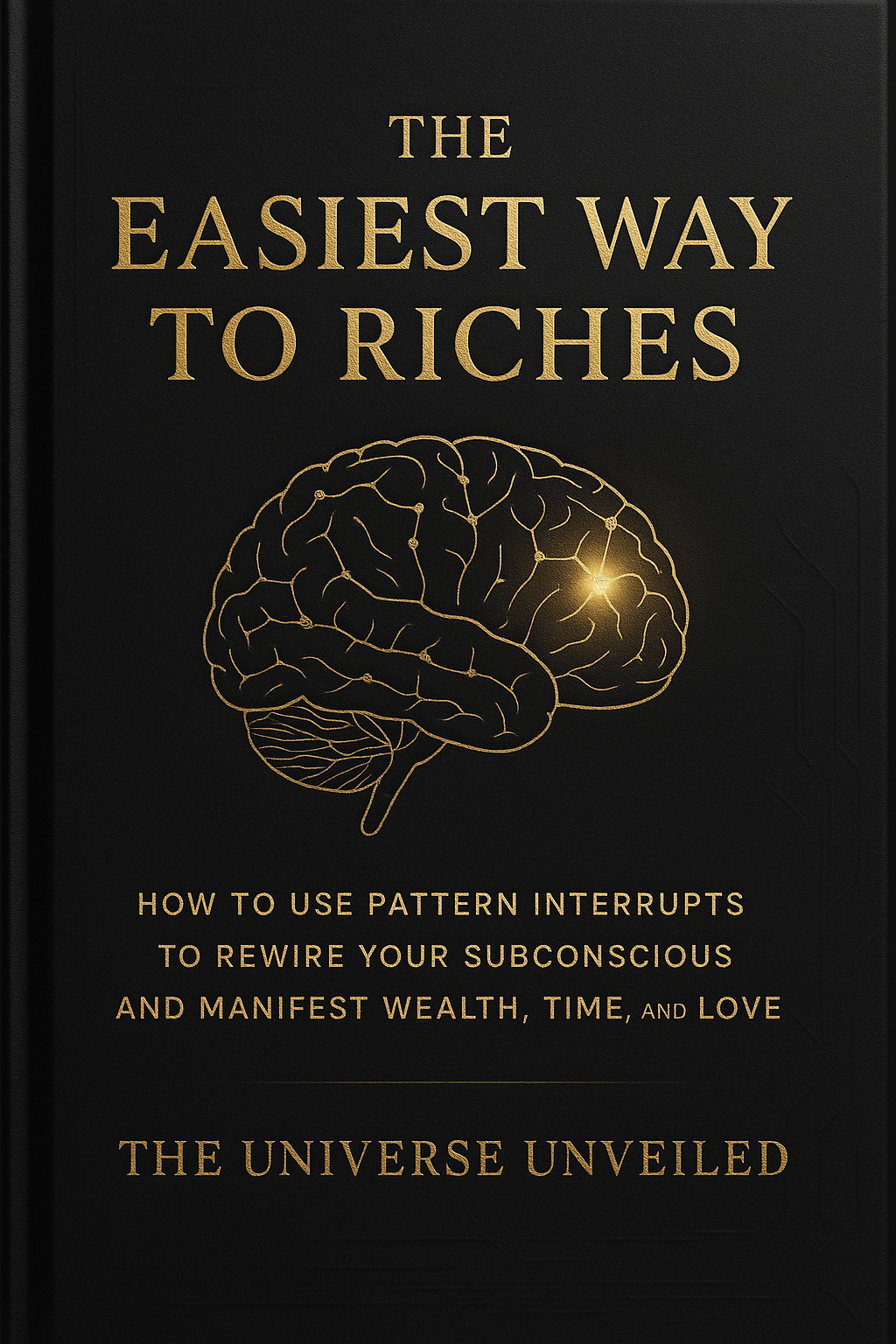Rewiring Your Subconscious Mind Through Neuroplasticity
Rewire your subconscious mind using neuroplasticity with 4 powerful steps: awareness, rewiring, interruption, and repetition.

The Universe Unveiled is a manifestation and subconscious mind mastery platform for conscious creators, seekers, and visionaries ready to reprogram neural pathways and align with universal law. In this post, we dive into the science of neuroplasticity—how the brain physically rewires itself through intention, repetition, and focused mental practice—to permanently reprogram the subconscious mind and activate new levels of manifestation.
You’re not just learning ideas—you’re reshaping your neural architecture. As thoughts become habits and repetition rewires your mind, you’re creating the biological foundation for sustained transformation.
Change begins with awareness and solidifies through practice. Modern neuroscience confirms what thinkers like Joseph Murphy and Neville Goddard long suggested: we can reprogram our subconscious minds by forming new neural pathways. The brain’s neuroplasticity – its ability to reorganize and rewire itself – is the key. By consciously practicing new thoughts and behaviors, you strengthen new neural connections and override old patterns. Below are four digestible steps to help you tap into neuroplasticity and rewire your subconscious mind.
No time to read? No worries! Listen to the full podcast below.
This episode reveals how neuroscience is finally proving what Neville Goddard and Joseph Murphy taught decades ago: you can rewire your subconscious mind. Learn the 4-step method using neuroplasticity to shift your beliefs, change your patterns, and create a new reality from within.
1. Awareness – Shine a Light on the Unconscious Patterns
You can’t change what you’re not aware of. The first step is to bring your hidden beliefs, thought patterns, or habits into the light of conscious awareness. We spend much of our day on autopilot, with subconscious “mental software” driving our reactions. In order to change these default behaviors, we must become conscious of them: “In order to change our behavior, we have to become conscious to our subconscious behavior.” Noticing your inner dialogue and triggers without immediately reacting gives you a choice in how to respond.
To cultivate this self-awareness, use tools that help explore your inner world: journaling about your thoughts and feelings, doing shadow work to face the “hidden” side of your psyche, healing the inner child by reflecting on formative childhood experiences, or practicing meditation to observe your mind. These techniques help make the unconscious conscious. For example, journaling has been shown to expand your consciousness of habitual patterns, giving you more control and “ultimate empowerment” through choice. Likewise, shadow work involves exploring repressed emotions or traits; by addressing these hidden aspects, you connect with your unconscious mind to uncover valuable insights and self-acceptance. The more awareness you build, the more power you have to change a subconscious pattern.
2. Active Rewiring – Replace the Old with the New
Once you’ve identified a limiting belief or unwanted habit, it’s time to actively rewire it. Think of your brain as having well-trodden paths (old habits) that you now need to divert into new routes. This means intentionally interrupting the default pattern and replacing it with a new thought, belief, or behavior. Each time you choose a new response, you are essentially training your neurons to fire in a new way – and neurons that fire together wire together over time.
Practice the new desired thought or behavior frequently and consistently. If it’s a behavior, do it as often as possible; if it’s a thought or belief, affirm it to yourself regularly. Even when you cannot physically act out the new behavior, you can visualize it in detail. Remarkably, visualization (also called mental rehearsal) triggers similar brain activity as actually performing the action, and over time it physically strengthens neural connections just like real practice. In other words, vividly imagining yourself in the new mindset or habit helps build the same neural pathway in your brain as doing it for real.
Tools for active rewiring: Guided visualizations, mirror work, positive affirmations, and empowering mantras are excellent for reinforcing the new pathway. Science shows that positive affirmations can literally help reprogram your subconscious by leveraging neuroplasticity. For instance, repeating a mantra like “I am capable and calm” might feel merely symbolic, but this positive repetition trains your brain to adopt a more optimistic, confident default. Over time, these new mental routes become more familiar and comfortable for your brain than the old negative loops.
3. Interrupt Old Patterns – Break the Autopilot Loop
Be prepared: your old programming will try to sneak back in. Our brains love efficiency, so they tend to fall back on established habits to save energy. It’s not a sign of failure – it’s just neural inertia. When you catch yourself slipping into an old thought pattern or reactive behavior, notice it without judgment. Mindfulness is critical here: by staying present and aware of what you’re doing or thinking in the moment, you activate your brain’s conscious control centers and diminish the power of autopilot routines. This called a pattern interrupt.
The moment you become aware of a default negative loop, interrupt it. Take a deep breath, remind yourself that this is the old pathway, and deliberately shift to the new belief or action you’ve been practicing. This could mean cognitively reframing the situation – i.e. choosing a different, positive interpretation of what’s happening – or literally doing something different from your usual reaction. For example, if your old programming in a stressful moment is to self-criticize, you might pause and reframe it by saying, “I’m doing my best, and I am growing,” thereby swapping self-criticism with self-compassion. Such conscious reframing and thought replacement is essentially the work of CBT (Cognitive Behavioral Therapy) in action, and studies show that changing your thoughts in this way physically changes your brain over time.
Keep using your mental tools during these relapses. Turn to your affirmations or mantras to drown out the old narrative with a new empowering one. Close your eyes and visualize yourself responding in the new way. Each time you disrupt the old pattern and substitute a new response, you weaken the old neural pathway a little more and strengthen the new one. The brain will eventually get the message that the new pathway is more efficient and satisfying, especially as you reinforce it with positive rewards (like congratulating yourself for making the better choice). Stay patient and persistent – you are literally carving a new path in your brain, and that takes repeated effort.
The Breakthrough You Didn’t Know You Needed:

Reprogram with Our Best eBook
You’ve interrupted the thought—now rewrite the story.
This book is not just about wealth. It’s about reclaiming your mind.
Discover how one simple shift in thought can reprogram your entire reality—money, time, love, and freedom included.
4. Repetition – Wire In the New Pathway
Repetition is the mother of neuroplasticity. The more you repeat a thought or action, the more robust its neural pathway becomes. In the beginning, choosing the new belief or habit might feel unnatural or effortful because the neural circuit is still thin. But with daily practice, the circuit thickens and strengthens, while the old unused circuits start to weaken (a process sometimes called “synaptic pruning”). Consistent practice literally reconfigures your brain: as one psychologist puts it, with consistent effort and practice, individuals can leverage neuroplasticity to reshape their thought processes.
Make your new habit or thought part of your daily routine so that repetition is built-in. If you’re adopting a new behavior, do it every day, even if in a small way. If it’s a mindset or affirmation, reinforce it every morning or night. The key is frequency and emotion: repeating a new affirmation while truly feeling its positive emotion, or mentally rehearsing your new behavior vividly, will deepen the imprint on your neural networks. Neuroscience tells us that the brain prioritizes familiar pathways – so your goal is to make the new pattern the familiar, default one. As one neuroplasticity principle states: “Neurons that fire together, wire together.” Each repetition fires the neurons in your new pathway collectively, gradually binding them into a strong network. In time, this new network becomes your brain’s go-to route because it’s been fortified through practice.
Remember, patience and consistency are vital. Research has dispelled the myth that a habit forms in 21 days – it often takes much longer (on average around 66 days, though it varies) to truly automate a new behavior. Don’t be discouraged by this. Every single repetition is progress, and your brain is always changing. Indeed, neuroplasticity is an ongoing, lifelong capacity of the brain to adapt. By rehearsing your desired thoughts and actions day by day, you are effectively training your brain like a muscle, making the new pathways stronger than the old. Soon, what once took conscious effort will feel natural. Your subconscious will have been rewired to align with the new belief or behavior, thanks to your commitment to repetition.
Final Thoughts
Rewiring your subconscious mind is a journey of conscious creation. Through awareness, deliberate practice, interrupting old patterns, and lots of repetition, you are telling your brain “This is the new normal.” The beauty of neuroplasticity is that your brain will respond – it will reorganize itself to reflect your intentional focus. Stay consistent and self-compassionate through the process. Slip-ups are part of learning; each time you guide yourself back to the new path, you are strengthening your mental “muscle.” Over time, those four steps become a way of life: you think, feel, and act from your chosen beliefs rather than old conditioning. In doing so, you unleash the transformative power of your subconscious mind and move toward the life you consciously want to create. As Neville Goddard taught, imagination coupled with belief can shape reality – and now we see that neuroscience agrees, providing the mechanism by which our sustained thoughts can indeed reshape the very wiring of our brains.




